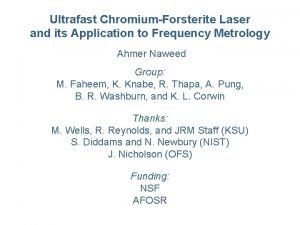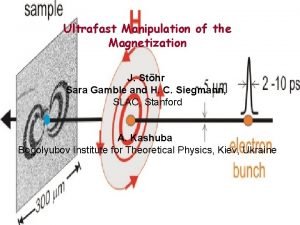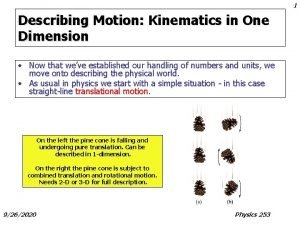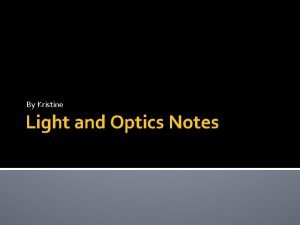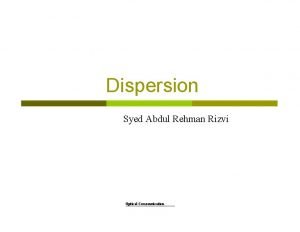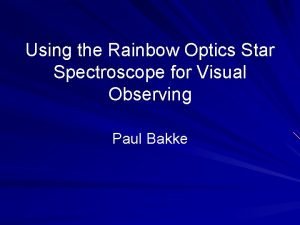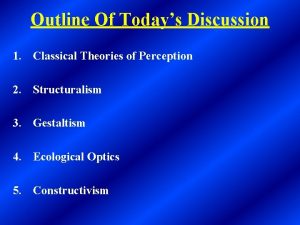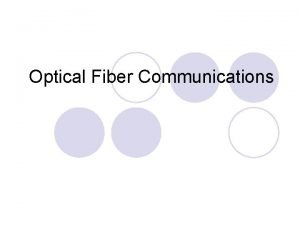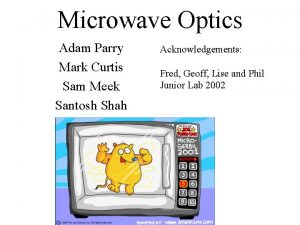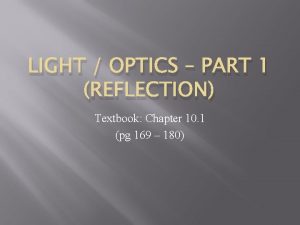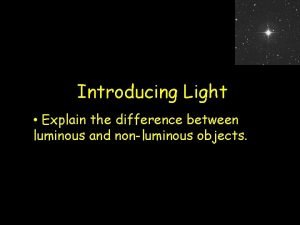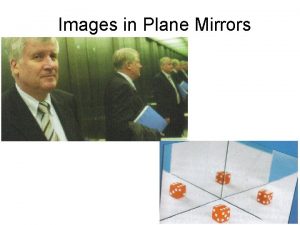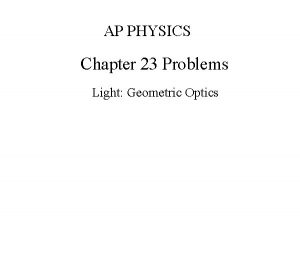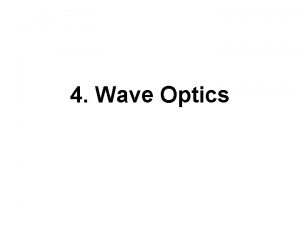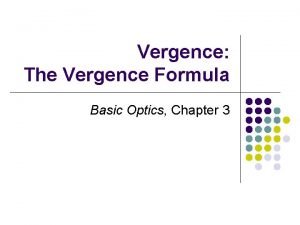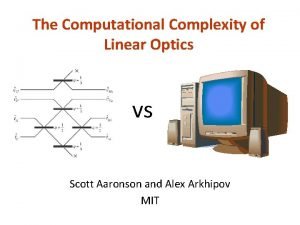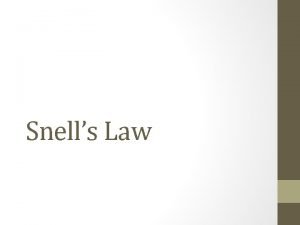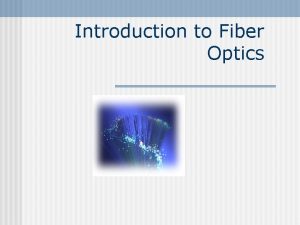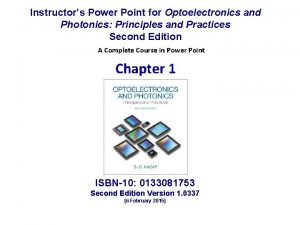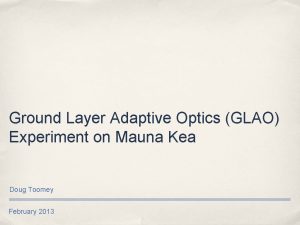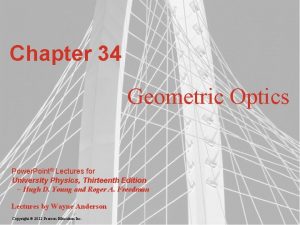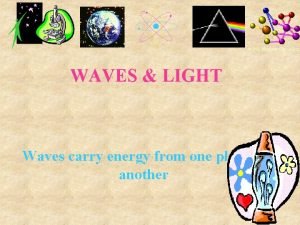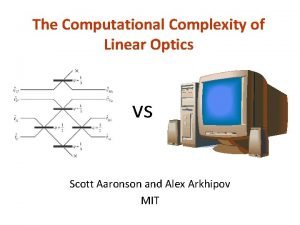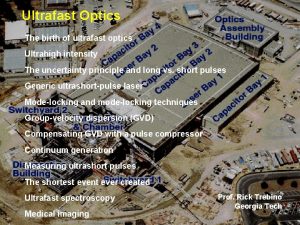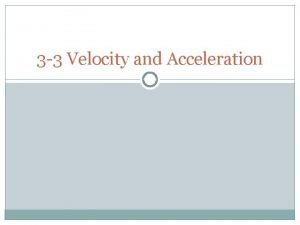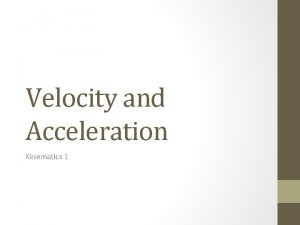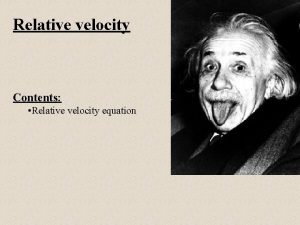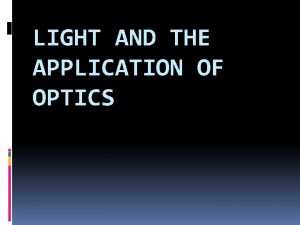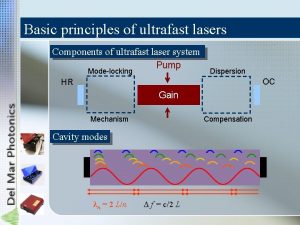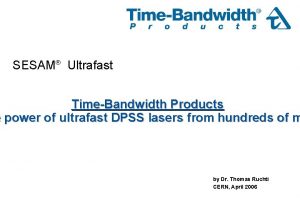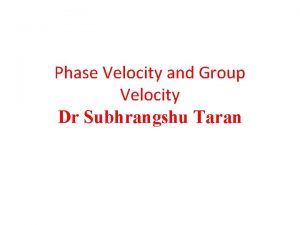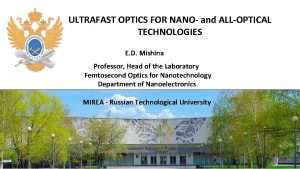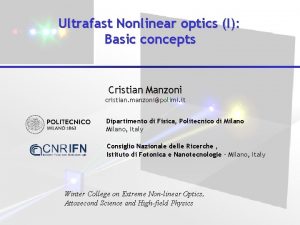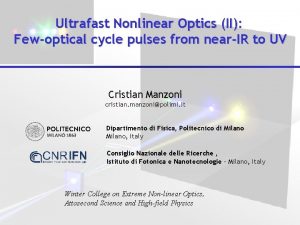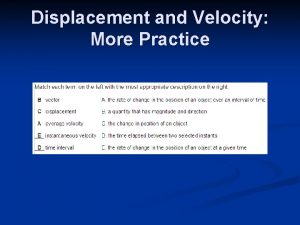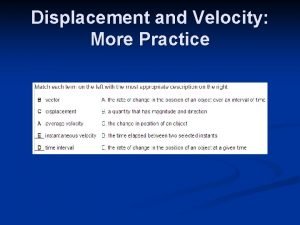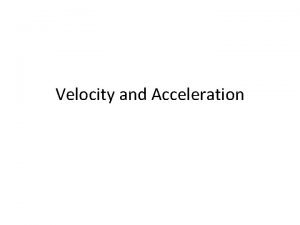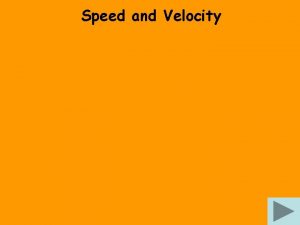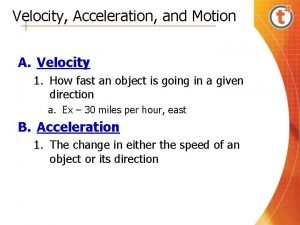Group Velocity and Ultrafast Optics Ultrafast 2016 James













































- Slides: 45

Group Velocity and Ultrafast Optics Ultrafast 2016 James Hendrie

Velocities Associated with Light Pulses • Phase • Ray • Group • Envelope

Derivation of Group Velocity t z z = ct z = vt

Slow/Fast Light • Manipulation of the Group Velocity within a dispersive medium

(dk/dΩ) ≡ Group Delay/L • Choosing materials that manipulate the speed at which light propagates Small (dk/dΩ) ≡ “Fast Light” • The idea that light travels much faster in materials with these small values of dk/dΩ “Fast Light”≡ Phase Sensitivity is Amplified • Large group delays amount to additional phase shift as light travels through the material. 5

Group Delay • NOT GROUP VELOCITY!!!

Carrier Envelope Offset • Beat Note

IPI Schematic Beat Note Measurement Phase Alteration D 8

Derivation of Envelope Velocity

Group Velocity Dynamics within Gain/Saturable Absorber

Fabry-Perot Etalon Inside a Mode-Locked Cavity

Nested Fabry-Perot in Mode. Locked Lasers to Monitor Minute Changes of Index James Hendrie, Koji Masuda, Adam Hecht, Jean-Claude Diels, and Ladan Arissian CLEO 2015 Ultrafast Class 2016

Motivation • Mode-locked lasers generate frequency combs which are sensitive to their parent cavities. • Inserting an etalon into the cavity generates a nested comb comprised of two repetition rates. • The ratio of these repetition rates can be used as an accurate measure of the optical path within the etalon. 13

Theory 14

Bunch Generation Pics from pics from latest paper

Bunch Generation t 16

Normalized Pulse Energy Bunch Generation Time (nano-sec) t 17

NRT = 1000 a = 0. 0002 R = 0. 05 Number of Pulses • Pulse bunch reaches steady state condition after many roundtrips Center of Gravity Shift (s) Bunch Generation 0 0 100 200 300 400 500 600 Number of Round Trips 700 800 900 1000 18

Gaussian in the Steady State Regime 500 Laser Cavity Round Trips 80 0. 1 0. 05 15 60 10 40 5 20 0 20 30 40 50 Fabry-Perot Cavity Round Trips 60 0 100 200 300 400 500 600 700 800 900 1000 Laser Cavity Round Trips Koji Masuda, James Hendrie, Jean Claude Diels and Ladan Arissian; Envelope, Group and Phase velocities in a nested frequency comb, Under Review. Number of Pulses 20 100 Center of Gravity Normalized Pulse Energy 0. 15

Fourier Transformation 146 ps 6. 4 ns 1 ns Time 155 MHz 6. 8 GHz 1 GHZ Frequency 20

Nested Comb Characterization 21

Nested Comb Characterization 22

The Real Thing

Pump Power Effect on Repetition Rate ML Cavity FP Cavity 24

Resonant Frequencies The central optical frequency, is resonant with both cavities Cavity and FP frequencies are defined via group indices 25

Frequency Ratio Want to measure this!! Group indices must be constant at each point 26

Three Experiments • Temperature • Radiation • Ring Laser Gyroscope

Temperature By changing the applied temperature of an intra-cavity Fabry-Perot etalon, one observes a change in frequency ratio.

Experimental Example SMALL Index changes due to applied heat SMALL 29

Experimental Setup 30

Temperature Diffusion in Glass Cap View Side View x z y 31

Center Line • Temperature change in the center of the etalon is very small 32

Fabry-Perot Angle Scan Internal Angle (milli radians) 33

Cavity Length Scan 34

Radiation K. Masuda, E. I. Vaughan, L. Arissian, J. P. Hendrie, J. Cole, J. -C. Diels, and A. A. Hecht, Novel techniques for high precision refractive index measurements, and application to assessing neutron damage and dose in crystals, Nuclear Instruments and Methods A (2014).

Ring Laser Gyroscope with Group Velocity Enhancement

Gyro Explanation • Counter propagating beams sharing a single cavity see equal and opposite phase shifts throughout the duration of any applied rotation to that cavity 37

Three Descriptions 1) Standing wave created by counter propagating beams 2) Doppler Shift 3) Counter propagating beams see different perimeters These descriptions hold true in both cw and pulsed operations!! The Gyro effect is inherently due to phase velocity!! 38

Standing Wave Description R 39

Doppler 40

Perimeter Change 41

Enhanced Gyro Derivation Taylor Expansion 42

Current Results Blue -> With FP Red -> Without FP

Current Results

Questions ? ?
 Difference between ray optics and wave optics
Difference between ray optics and wave optics Venn diagram of geometric optics and physical optics
Venn diagram of geometric optics and physical optics Ultrafast
Ultrafast Ultrafast demagnetization
Ultrafast demagnetization Ultrafast magnetism
Ultrafast magnetism Difference between linear and angular acceleration
Difference between linear and angular acceleration Initial velocity and final velocity formula
Initial velocity and final velocity formula Initial velocity and final velocity formula
Initial velocity and final velocity formula Unit 2
Unit 2 Is v final velocity
Is v final velocity Instantaneous velocity vs average velocity
Instantaneous velocity vs average velocity Darcy's law
Darcy's law Angular velocity to tangential velocity
Angular velocity to tangential velocity Angular acceleration formula in terms of radius
Angular acceleration formula in terms of radius Clay lawson and russell odom
Clay lawson and russell odom James clayton lawson
James clayton lawson Basic electricity and optics
Basic electricity and optics Disadvantages fiber optic
Disadvantages fiber optic Light and optics notes
Light and optics notes Infrared light is also known as bill nye
Infrared light is also known as bill nye Group velocity dispersion
Group velocity dispersion Rainbow optics star spectroscope
Rainbow optics star spectroscope Gestaltism
Gestaltism Turba optics
Turba optics Types of optics
Types of optics Sam meek
Sam meek Bill nye light optics worksheet
Bill nye light optics worksheet Grade 10 optics
Grade 10 optics What is the difference between luminous and non luminous
What is the difference between luminous and non luminous Characteristics of plane mirror
Characteristics of plane mirror Hotwire salisbury nc
Hotwire salisbury nc Http //www.phys.hawaii.edu/ teb/optics/java/slitdiffr/
Http //www.phys.hawaii.edu/ teb/optics/java/slitdiffr/ Optics topics
Optics topics Astigmatism classification
Astigmatism classification Optics
Optics Fourier optics
Fourier optics Vergence formula
Vergence formula The computational complexity of linear optics
The computational complexity of linear optics What is the snell's law
What is the snell's law Introduction to fiber optics
Introduction to fiber optics Cauchy formula optics
Cauchy formula optics Adaptive optics
Adaptive optics Geometrical
Geometrical Geometric optics ppt
Geometric optics ppt What medical procedure uses fiber optics bill nye
What medical procedure uses fiber optics bill nye The computational complexity of linear optics
The computational complexity of linear optics


